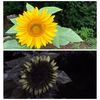What is photo stacking?
Jun 24, 2019 11:02:54 #
bleirer wrote:
Wonderful URL that you provided, bleirer! Cambridgeincolour has another link that I believe is complementary to this: https://www.cambridgeincolour.com/tutorials/focus-stacking.htm.It is combining several similar images into one im... (show quote)
Jun 24, 2019 13:45:45 #
billnikon wrote:
Photo stacking is a process where a individual or individuals place one paper photo on top of another paper photo. This unique process can be continued until the individual or individuals tire or run of of paper photo's.
Very funny, Bill!!!
I'll bet you're a Card!!!! (Player)?!!!!!
Jun 24, 2019 13:50:06 #
Jun 24, 2019 13:52:31 #
John Sh wrote:
This is a good description but there is an easier ... (show quote)
So, how many books would one typically read whilst the camera/computer, and then, Photo Editor would be doing THEIR thing, John?
Also - got any good book recommendations?

Jun 24, 2019 13:56:40 #
BOB WETHERELL wrote:
I don’t have a laptop, is there an app for an iPad?
It is in the App Store. And the Helicon and Zerene full on stacking software both come in mac versions.
Jun 24, 2019 14:05:00 #
LasVegasCindy wrote:
Hello All,
I have been seeing posts and photos related to photo stacking. Can someone please explain in plain terms, what it is and how is it achieved? I’m guessing it is done in post processing but honestly do not have a clue! So much to learn! Thanks in advance for any responses!
I have been seeing posts and photos related to photo stacking. Can someone please explain in plain terms, what it is and how is it achieved? I’m guessing it is done in post processing but honestly do not have a clue! So much to learn! Thanks in advance for any responses!
Cindy - Gene's response, thus far - is the most explicit, be it also - the most complicated.
If you have a late model DSLR - including most Sony models, and some of the more recent Canons, and Nikons, you will find you can initiate HDR from the menus. This is a simplified way of doing Focus Stacking, and will allow the camera to do all the work. It will take 3-5 images of the subject, at hand, layering them all on top of each other - to give you the best Photo (with them all compiled) automatically!
Jun 24, 2019 14:47:54 #
Chris T wrote:
Cindy - Gene's response, thus far - is the most ex... (show quote)
HDR and photostacking are 2 different subjects. Please don’t confuse someone with inaccurate information.
Walt
Jun 24, 2019 15:23:41 #
bleirer wrote:
It is combining several similar images into one im... (show quote)
Thank you for taking the time to help! I will definitely check out the link you provided!
Jun 24, 2019 15:25:20 #
rwilson1942 wrote:
The most common type of stacking is 'focus stacking'.
https://www.google.com/search?client=firefox-b-1-d&channel=cus&q=focus+stacking
https://www.google.com/search?client=firefox-b-1-d&channel=cus&q=focus+stacking
Hi Rick, thanks for the link! I will check it out!
Jun 24, 2019 15:27:52 #
robertjerl wrote:
Some will stack 1-200 or more shots of the night sky to get rid of the noise and have a BLACK sky behind the stars or moon.
WOW! I guess the number of images one can use is limitless? Who has that much time? Thanks for your comment, Robert!
Jun 24, 2019 15:35:54 #
billnikon wrote:
Photo stacking is a process where a individual or individuals place one paper photo on top of another paper photo. This unique process can be continued until the individual or individuals tire or run of of paper photo's.



What's a paper photo? Just kidding!! Thanks for the humor!
Jun 24, 2019 15:45:53 #
Gene51 wrote:
Some photographers will use stacking to achieve de... (show quote)
Hello Gene! Thank you so much for taking the time to answer my question. I appreciate the detail of your response. I understood most of it but can honestly say, I will need to do some studying!!
Jun 24, 2019 15:49:00 #
traderjohn wrote:
Place the camera on a sturdy tripod – a must! br F... (show quote)
Thanks, TraderJohn! I appreciate you taking the time to post!
Jun 24, 2019 15:51:56 #
John Sh wrote:
This is a good description but there is an easier ... (show quote)
Thank you, John! This photo is amazing and very interesting!
Jun 24, 2019 15:55:47 #
bleirer wrote:
Some cameras have focus stacking built in and you can just tell it the max number of images and the focus increment. You still have to process the stack in the software that comes with the camera or some other software, it doesn't come out of the camera as one image, at least not mine.
Thanks for this information. What camera(s) do you use?
If you want to reply, then register here. Registration is free and your account is created instantly, so you can post right away.



